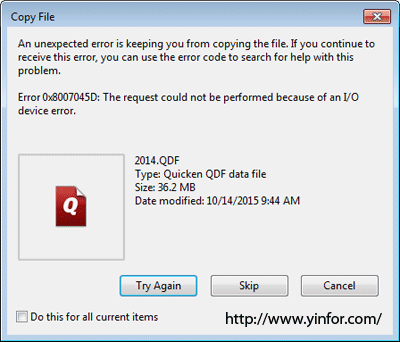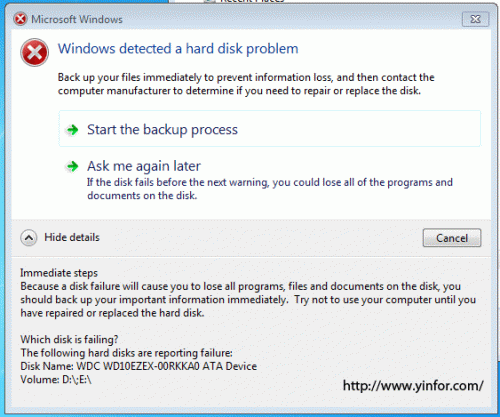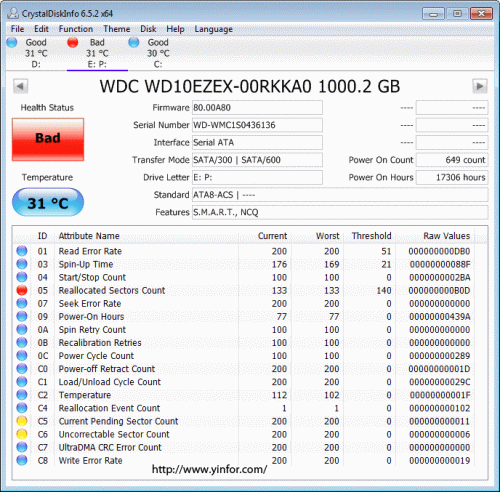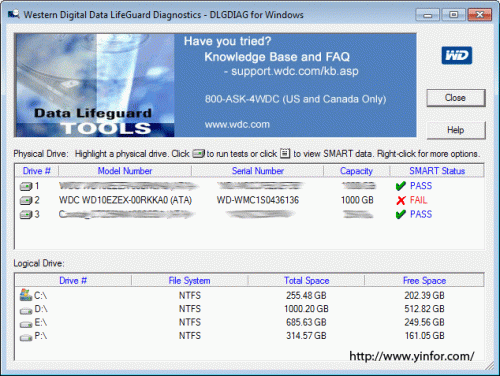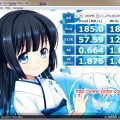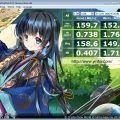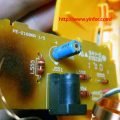It is a WD10EXEZ SATA,64MB Cache 1.0TB hard disk. I bought it in the end of 2012. Now it is almost three years.
I found it is not working yesterday morning. The Windows 7 can not found the hard drive when I boot up it. It can be found after a reboot.
But, some files are not able to access.
So I tried to do the backup all the important files. Most of the files can be copied to the backup media. The error of some missing files are shown as below.
I have to skip these kind of files to continue. And during the backup, the disk error shown randomly.
I run two tools to check this disk status and get more information.
First, CrystalDiskInfo 6.5.2.
Second, Western Digital Official tool, Data LifeGuard Diagnostics.
I can see the S.M.A.R.T information. Three main error or warning. I check the Wikipedia page.
Reallocated Sectors Count
Count of reallocated sectors. When the hard drive finds a read/write/verification error, it marks that sector as “reallocated” and transfers data to a special reserved area (spare area). This process is also known as remapping, and reallocated sectors are called “remaps”. The raw value normally represents a count of the bad sectors that have been found and remapped. Thus, the higher the attribute value, the more sectors the drive has had to reallocate. This allows a drive with bad sectors to continue operation; however, a drive which has had any reallocations at all is significantly more likely to fail in the near future.[3] While primarily used as a metric of the life expectancy of the drive, this number also affects performance. As the count of reallocated sectors increases, the read/write speed tends to become worse because the drive head is forced to seek to the reserved area whenever a remap is accessed. If sequential access speed is critical, the remapped sectors can be manually marked as bad blocks in the file system in order to prevent their use.
Current Pending Sector Count
Count of “unstable” sectors (waiting to be remapped, because of unrecoverable read errors). If an unstable sector is subsequently read successfully, the sector is remapped and this value is decreased. Read errors on a sector will not remap the sector immediately (since the correct value cannot be read and so the value to remap is not known, and also it might become readable later); instead, the drive firmware remembers that the sector needs to be remapped, and will remap it the next time it’s written.[39] However some drives will not immediately remap such sectors when written; instead the drive will first attempt to write to the problem sector and if the write operation is successful then the sector will be marked good (in this case, the “Reallocation Event Count” (0xC4) will not be increased). This is a serious shortcoming, for if such a drive contains marginal sectors that consistently fail only after some time has passed following a successful write operation, then the drive will never remap these problem sectors.
Uncorrectable Sector Count
The total count of uncorrectable errors when reading/writing a sector. A rise in the value of this attribute indicates defects of the disk surface and/or problems in the mechanical subsystem.
In short, there are too many bad sectors and they can not be recovered.
OK, I have to buy a new hard disk to replace it. Before that, do the backup first, try my best to backup as more as possible.
